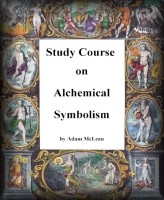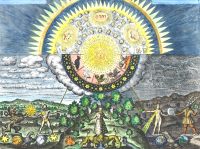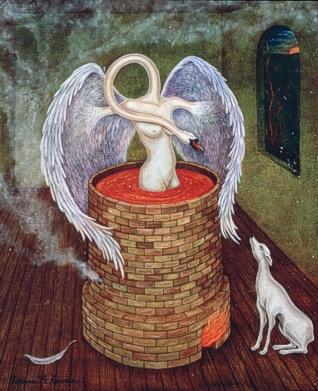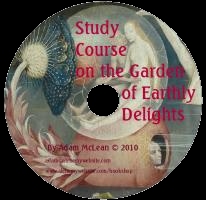
|
|
Alchemical paintings of Kurt GodwinBack to Contemporary artists influenced by alchemyCarousel/Alchemy series based on "The Twelve Keys of Basil Valentine'. These paintings, in various combination, have been in several two man shows at local colleges and Universities and currently the ten paintings completed at this point are part of a solo show at the University of Maryland. Although I don't assume the average viewer to be well versed on the subject, many have at least become aware of the spiritual aspect to alchemy. While these paintings can be appreciated solely from their color and compositional aspects, people respond strongly to the alchemical content without prior knowledge of its significance. Perhaps this gives some credence to Jung's thoughts on the nature of this imagery as rooted in mankind's collective unconscious. Out of respect for the complex symbolic significance of these historic pictures it is important to me that these images would not be manipulated. Any alteration would alter the intent of the symbolism, whether or not its meaning is understood at this time. This series is part of an evolution of work that began with depictions of ferris wheels, and then carousels, as metaphors for the karmic wheels of life and fortune. My dilemma on how to gracefully assimilate my interest with alchemy with my painting ideas was solved by using the carousel platform as a stage.
A few incidental notes on these paintings:
Geometrical deconstructions of the keys: Geometrical deconstruction of fifth key Geometrical deconstruction of eighth key Geometrical deconstruction of twelfth key Other paintings with an alchemical theme: Ouroborus Conjuncture
The Carousel/Alchemy Paintings (1997-1999) Artists Statement - Kurt Godwin The carousel, as a metaphor, has several universal connotations generally dealing with the idealized innocence of youth. As a ride that revolves, (similarly with the ferris wheel), its circular path can also signify of the Wheel(s) of Life & Fortune. Combining these views of the carousels symbolism: innocence lost, the constancy of life, and fate, are an allusion to the individual, and society at large, poised in time at the end of this century and the beginning of the new millennium. The fantastic, surrealistic images of the 17th c. alchemy text, The 12 Keys of Basil Valentine, were intentionally heavily coded, metaphorical allegories that pertain to the procedures of the alchemical 'great work'. This great work has been interpreted as achieving the ability to turn base metal into gold. While the exact definitions of these mysterious pictures are now lost to us, one interpretation developed by psychologist Carl Jung identifies this type of image as universal archetypes of the collective unconscious. A more complete assessment of alchemy and the imagery related to it is in the personal search and struggle for a higher self awareness or enlightenment, a purpose believed to be the actual, primary goal of the true alchemical philosophers. In this way I construe these two images to be related: The carousel depicts the "conscious" world image of life's path and the alchemy image depicts the "unconscious" spiritual counterpart. This is also an example of the alchemist search for the union of opposites. The origins of the carousel as a devise to train medieval royal youth in the ways of war presents another dichotomy in combination with its more well known, carefree nature. The alchemy images used are reproduced in their original form, treated as flat, two dimensional drawings to retain its role as a symbol. Superimposed over the carousel the alchemy figure, colorless in itself, take on the colors of the carousel, altering them where they overlap. The carousel becomes a stage for the alchemical scenarios. The interplay of the "real" and "imagined" blur and shift. Perspective space is implied yet confounded with ambiguity. This imagery woven together combined with orchestrated systems of color combinations result in structures closer to the mandala than western pictorial devices. Although the content derives from western civilization the resulting abstract, layering suggests the contemplative nature of the east. As with the yin/yang, eastern symbol for the unification of opposites, it becomes clear how profound yet simple, elemental truths can be. As we face the unknown of the future it is important to realize the essence of some forgotten truths from the past.
Kurt Godwin
|
Alchemical texts 16th Century Practical alchemy Philosophical alchemy 17th Century Practical alchemy Philosophical alchemy 18th Century Practical alchemy Philosophical alchemy Alchemical poetry Alchemical allegories Works of Nicolas Flamel Works of George Ripley Works of Sendivogius Theatrum Chemicum Britannicum Emerald tablet of Hermes Rosicrucian texts Literary works Texts from Musaeum Hermeticum Spanish alchemical texts German alchemical texts French alchemical texts Russian alchemical texts Italian alchemical texts  Study Courses
Study Courses Alchemical, astrological and emblematic art prints  Alchemy and art  Art books Series  Study course on Bosch's Garden of Earthly Delights New Hieronymus Bosch Website |